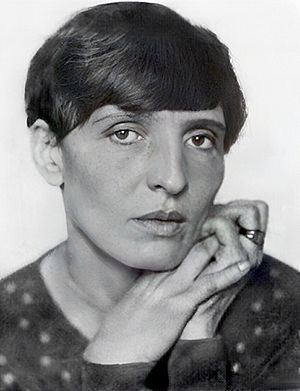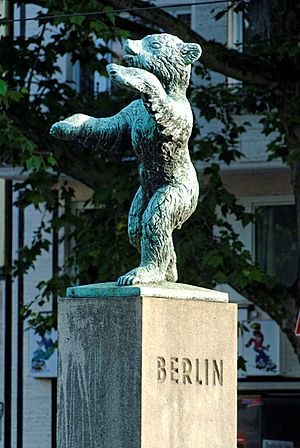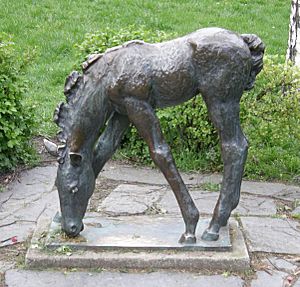Renée Sintenis facts for kids
Quick facts for kids
Renée Sintenis
|
|
|---|---|

Renée Sintenis in a photograph by Hugo Erfurth (1930)
|
|
| Born |
Renate Alice Sintenis
20 March 1888 Glatz, Prussian Silesia, German Empire (present-day Kłodzko, Poland)
|
| Died | 22 April 1965 (aged 77) |
| Nationality | German |
| Known for | Sculpture, medalist, graphic artist |
| Movement | Expressionism |
| Olympic medal record | ||
|---|---|---|
| Art competitions | ||
| Bronze | 1928 Amsterdam | Sculpture |
Renée Sintenis (born March 20, 1888 – died April 22, 1965) was a famous German artist. She was a talented sculptor, which means she made statues. Renée also created medals and graphic art. She worked in Berlin for most of her life.
Renée Sintenis was best known for her small animal sculptures. She also made statues of people, including portraits and sports figures. Her most famous works are her Berlin Bear sculptures. These bears were later used as the design for the top award at the Berlin International Film Festival, called the Golden Bear.
She was born in a place called Glatz and passed away in West Berlin. In 1917, she married a painter and writer named Emil Rudolf Weiß. In 1928, she won a bronze medal at the Olympic Games for her sculpture of a football player.
Contents
Early Life and Art Training
Renate Alice Sintenis was born on March 20, 1888. She was the first of three children. Her father, Franz Bernhard Sintenis, was a lawyer. Her family name, Sintenis, comes from a group of people called Huguenots.
Renée grew up in a town called Neuruppin until 1905. Being close to nature there helped inspire her art later on. In 1905, her family moved to Berlin. Her father got a job at a higher court there.
While still in school, Renée took drawing lessons. In 1907, she began studying decorative sculpture in Berlin. She studied with teachers like Wilhelm Haverkamp and Leo von König. After some time, she left her studies. She had a difficult time after leaving her family.
Becoming a Sculptor
In 1910, Renée Sintenis met a sculptor named Georg Kolbe. She became his model, posing for his sculptures. This helped her learn more about art. They became good friends, and he supported her artistic journey.
After 1915, Renée started creating the animal figures she became famous for. She loved making small sculptures. She didn't like making huge, monumental statues. Her small artworks, like horses, deer, donkeys, and dogs, were very popular. People liked them because they were more affordable. They also made great gifts and fit well in smaller homes.
In 1913, Renée began having her sculptures cast at the Hermann Noack fine art foundry. This is a special place where artists turn their clay or plaster models into metal statues. She worked with them for many years.
In 1917, she married Emil Rudolf Weiß. He was a talented artist who designed books and painted. He had been her teacher and friend. Emil supported Renée and introduced her to many other artists. They worked together on a few projects. One famous project was a book of poems by Sappho. Renée made the etchings, and Emil designed the fonts.
From 1913, Renée regularly showed her sculptures in exhibitions. Other artists, like Max Liebermann and Max Beckmann, admired her work. In 1922, a new art gallery opened in Berlin. This made her a very important artist in the city's art scene. People loved her sculptures of athletes, portraits of her friends, and small self-portraits.
Renée Sintenis was also often photographed by famous photographers like Hugo Erfurth. She was known for her slim figure and confident style. She was seen as a symbol of the "new woman" of the 1920s.
During the 1920s, Renée Sintenis became famous around the world. Her art was shown in major galleries. These included the Berlin Nationalgalerie, the Tate Gallery in London, and the Museum of Modern Art in New York. Her small sculptures of athletes, like boxers and football players, were collected worldwide.
In 1928, Renée won a bronze medal at the 1928 Summer Olympics in Amsterdam. She won it in the sculpture section of the art competition for her work "Footballeur" (Footballer). In 1931, she became one of the first women to join the Berlin Academy of the Arts.
In 1932, she created a statue of the Berlin Bear. This bear stands on its back legs with its arms raised. It was inspired by the Coat of arms of Berlin. This design became very popular. She sold many 15 cm (about 6 inches) statues of the bear. This brought her a lot of success.
Challenges During the 1930s
Life became difficult for Renée Sintenis and her husband in the 1930s. Her husband, Emil Rudolf Weiß, lost his university job in 1933. This was because he spoke out against the Nazi government.
Renée Sintenis was also forced to leave the Academy of the Arts in 1934. This was due to her family background. Even so, she was allowed to stay in the Reich Chamber of Culture. However, the Nazis removed her artworks from public collections.
During this time, Renée Sintenis continued to create art. One of her self-portraits was shown in an exhibition called "Degenerate Art" in 1934. This exhibition was meant to criticize modern art. Despite the challenges, she still exhibited her work. However, she did not earn as much money as before. In 1941, it became even harder when bronze casting was banned.
Her husband, Emil Rudolf Weiß, died suddenly in 1942. This was a very hard time for Renée. She took over his art studio. In 1945, her studio was destroyed by fire and bombings during the war. Renée lost almost all of her belongings. Many of her papers and artworks were lost.
Post-War Success

After World War II, Renée Sintenis moved into a new apartment in Berlin in 1945. In 1948, she received an art prize from the city of Berlin. She was also asked to teach at the Berlin University of Fine Arts. She became a full professor in 1955, but she stopped teaching that same year. She also joined the new Academy of the Arts of Berlin (West) in 1955.
In the 1950s, Renée Sintenis became very successful again. She continued to focus on her favorite subjects: making animal sculptures. She called this her "making animals" work.
In 1953, copies of her famous "Bär" (Bear) sculpture were used as awards for the first time. These were given out at the third Berlin International Film Festival (Berlinale). Since then, the bronze Golden Bear has been the top award at the festival. Later, Silver Bear awards were also introduced.
In 1957, a life-size bronze sculpture of Renée Sintenis's Berlin Bear was placed on a highway in Berlin. Another copy was placed in Düsseldorf in 1960. A third bronze bear monument was put on a highway near Munich in 1962.
In 1963, one of her bear sculptures was given to John F. Kennedy when he visited Germany.
Later Life and Legacy
On her 70th birthday in 1958, an exhibition of her work was held in Berlin.
Renée Sintenis passed away on April 22, 1965. She is buried in the Waldfriedhof cemetery in Berlin-Dahlem. Her grave is considered an honor grave by the State of Berlin.
In 2018, her artwork was part of an exhibition called "Lesbian Visions" in Berlin.
A bear sculpture created by the Noack foundry in 1976 stands in Griffith Park, Los Angeles. It has a plaque that says it was given by the people of free Berlin to the people of the United States. This was to thank them for their help and friendship.
As of 2022, the Golden Bear awards for the Berlinale are still made by the Noack foundry.
Honors and Awards
Renée Sintenis received several important awards for her work:
- In 1952, she was given the "Knight of the Peace Class" of the Pour le Mérite order.
- In 1953, she received the Great Federal Order of Merit.
Where to See Her Art
Renée Sintenis's sculptures can be found in many public art collections around the world, including:
- Art Institute of Chicago
- The Museum of Modern Art, New York
- National Gallery of Art, Washington, D.C.
- Los Angeles County Museum of Art
See also
 In Spanish: Renée Sintenis para niños
In Spanish: Renée Sintenis para niños


